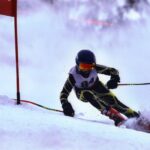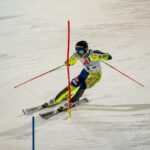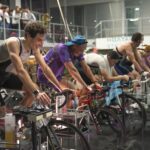In a recent post titled, My 5 Biggest Pet Peeves in Gate Training, I introduced you to the common training habits of young racers that really irritate me (and, more importantly, prevent them from getting the most out of their training!). There is nothing more important to achieving your ski racing goals than what you do in training. It is during training that you ingrain the physical, technical, tactical, and mental habits that will come out in races. If you establish good habits, you’ll have a good chance of having a good race. But if you instill bad habits, those will come out and you’ll have no chance of achieving your goals.
Here are my 5 “must dos” that can help you get the most out of your training:
- Have a goal and purpose. You must have a clear goal about what area you want to improve as you head out to training. For example, a good goal might be to shift your weight forward so you’re not caught “in the back seat.” You must also have a clear purpose for training each day. A purpose identifies specifically how you’re going to achieve your goal for the day. Returning to the example I just cited, your purpose might be to drive your hands forward between turns or bring your hips up to get your weight forward.
 When I’m working on the hill with racers, I will often ask them what their goal and purpose is. If they don’t know, I don’t let them train. I know that sounds harsh, but think of it this way. If you don’t have a clear goal and purpose, you won’t be working on anything to improve. You will not only not be getting better, but you will be making it harder to improve. Let me explain. When you’re not working on something, you are practicing and further ingraining old habits. The more deeply ingrained those old technical, tactical, and mental habits get, the harder it is to change them. So, by not having you train if you don’t have a clear goal or purpose, you may not be improving, but, at least, you’re also not making it harder to improve.
When I’m working on the hill with racers, I will often ask them what their goal and purpose is. If they don’t know, I don’t let them train. I know that sounds harsh, but think of it this way. If you don’t have a clear goal and purpose, you won’t be working on anything to improve. You will not only not be getting better, but you will be making it harder to improve. Let me explain. When you’re not working on something, you are practicing and further ingraining old habits. The more deeply ingrained those old technical, tactical, and mental habits get, the harder it is to change them. So, by not having you train if you don’t have a clear goal or purpose, you may not be improving, but, at least, you’re also not making it harder to improve.
- Train like you race. When I ask coaches and racers whether they should train like they race or race like they train, the vast majority say race like you train. Their answer seems reasonable because if you could race in the same relaxed state as when you train, the chances are you’d ski well.
The problem is that racing like you train is impossible. Why? Because there is a big difference between training and races: races matter! So I say train like you race. Think about everything you need to think, feel, and do in a race and then replicate that in training. By doing so, you will practice and ingrain the skills and habits that you need to ski your best in races.
 When I say train like you race, I don’t mean trying to ski as fast as you can every run of training. The reality is that there are times in training when you will be focusing on technique or tactics rather than speed. When I say train like you race, I mean putting 100% effort, focus, and intensity into whatever you are working on.
When I say train like you race, I don’t mean trying to ski as fast as you can every run of training. The reality is that there are times in training when you will be focusing on technique or tactics rather than speed. When I say train like you race, I mean putting 100% effort, focus, and intensity into whatever you are working on.
Admittedly, you probably won’t be able to train at 100%, but if you can up your efforts from, say, 70% to 90%, when you get to race day, you’ll have little trouble kicking it up to 100% because your mind and body know that it’s time to race.
By training like you race, you won’t need to do anything new or different on race day. And races won’t feel like a big deal because you’ve been skiing at that high level in training. All of those great skills and habits that you instilled in training will naturally come out and you’ll be able to ski your fastest.
- Use keywords to maintain focus. Perhaps the greatest challenge you face in improving the technical and tactical aspects of your skiing is maintaining focus in training. In fact, ski racing may be the most difficult sport in which to focus because there are so many things to focus on (e.g., course, terrain, snow conditions) and so many thing trying to distract you (e.g., speed, homework, people). For example, in the starting gate of a training course, you may be totally focused on, say, keeping your hands up. But, as soon as you leave the gate, you find you have a lot more important things to focus on, such as survival!
As soon as you lose your focus, you lose your ability to work on that thing you were focusing on in the starting gate. Here’s a simple rule: If you don’t focus on it, you won’t work on it. If you don’t work on it, you won’t learn it. And if you don’t learn it, you won’t be able to use it in a race.
The best way I have found to maintain focus on a training course is to develop and repeat a keyword that will remind you to focus on and practice what you are working on to improve. Returning to my example of keeping your hands up, think up a simple keyword (best to have it one or two syllables and active), such as up, drive, press, or forward. Then, in the starting gate and during the entire training run, repeat the keyword to yourself (out loud if necessary). If you’re saying the keyword, you have a much better chance of not being distracted, keeping the focus on the technique you’re working on, actually practicing it the entire training run, and ingraining it so that it is automatic.
- Make mistakes. One of the most frustrating aspects of developing as a ski racer are the mistakes that you make as you work to improve. Unlike in other sports, the consequences of mistakes in ski racing are dramatic and sometimes painful, in the forms of blowing out in training courses or crashing in races. Yet, racers often don’t realize that mistakes are an essential part of becoming a better racer. In fact, many racers view mistakes as failure; if they didn’t have a perfect run, they’ve failed. In fact, many racers I see bail out of courses at the first hint of trouble. But mistakes only mean failure when you give in to them, don’t learn from them, and keep repeating them.
Mistakes are a natural part of the learning process and offer you valuable information about what you need to work on. Mistakes are actually positive signs in ski racing because they mean you’re taking risks, moving out of your comfort zone, and working to improve. If you are not making mistakes, you’re just not pushing yourself to be your best.
Rarely has there ever been a perfect race run, even by World Cup racers. The best ski racers in the world make mistakes, so if you’re not at that level, you shouldn’t be surprised that you make mistakes too. What makes World Cup racers different is not that they don’t make mistakes, but rather how they respond to them. Instead of getting frustrated, angry, and depressed when they make mistakes, the best racers stay positive and motivated. And, importantly, they learn from their mistakes so they don’t make them again. To ensure that mistakes mean success, immediately after a mistake, identify what exactly you did incorrectly, decide what you need to do to correct it, and focus on the correction on the next run.
- Have patience, persistence, and perseverance. Two significant barriers to achieving your ski racing goals are frustration and discouragement. Let’s face it, ski racing is filled with obstacles, plateaus, and setbacks, and it’s easy to just want to give up. I think it’s especially hard for young racers these days because all of the messages they get from popular culture is that success should easy and they shouldn’t have to work that hard to get it. But that’s just not the way the real world works. Gosh, pursuing excellence is just plain difficult. That’s why most people never get there, because they quit when it gets hard.
I read a research study once that said that it takes 2,000 repetitions of a skill to ingrain it fully. The problem is that you can’t just make that many repetitions to really learn something. Rather, you have to have 2,000 quality repetitions, which means you may need to do several thousand more to get to that number. Also, other research shows that those who achieve excellence have put in thousands of hours of practice.
If you’re going to achieve your ski racing goals, you need the 3 Ps of training. The first P is patience, really understanding that there is no magic and there are no quick and easy paths to success. You must be willing to accept that it will take a long time to reach your goals. The second P is persistence, which means keeping up maximum effort even when you are tired, bored, cold, and wishing you could somewhere else. The third P is perseverance, which involves facing and overcoming those obstacles, plateaus, and setbacks that are an inevitable part of the climb up the steep mountain to your goals.
In my next post, I’ll introduce you to My 5 Biggest Pet Peeves on Race Day. If you’d like me to include your own personal race-day pet peeves, please post them on my Facebook page.
It’s never too late to begin mental training during a race season. Take a look at my online mental training courses designed specifically for ski racers.






